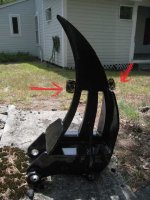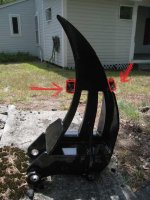CM, I understand your question. Of course I don't know empirically whether a ripper with saw teeth protusions would not work as well or better than what I fabricated. And, what I put together was largely determined by materials at hand which is far different than MIE has available (to say nothing of the huge gap in fabrication skill

).
First a clarification. I think from your last post that you think I cut the drill pipe longitudinally before welding it to the ripper blade face. I did not. What I welded to the ripper was simply a "chunk" or piece of the drill pipe, a complete, round section about two inches long. Water would still flow through it. I tacked it to the ripper blade edge and then welded in fillets to support it in place. So, the drill pipe section is roughly 1.5 inches proud of the ripper blade edge. Looks like crap but it has a full circle of sharp edges that are perpendicular to the main ripper blade and protrude above the blade. Think meat hook.
A saw type blade might well accomplish the same thing as I think my cobbled together, butt ugly modification. However it seems to me that the two modifications may behave a bit differently. As you note, a saw type modification would cut against the root even as the root started to slide across the ripper and would therefore nip at the root multiple times (however many teeth MIE cuts into the blade) as the ripper rubs against the root. There would be pressure against the root too so as the saw action cut the root it would pretty quickly reach a point where the root would just break. Understood. While I don't doubt that would be a significant improvement, what I am a bit concerned about with the saw approach is that you don't really want to saw back and forth as that motion is hard to do with a backhoe. What you want is for the thing to rip through in the first curl. If the teeth are cut so there is a 45 degree angle cutting into the root I don't know if that will snag the root or allow it to pass over the top with just a 1/4 inch or 1/2 inch slice into the root. Snagging is desirable IMO as we pretty much know the ripper has the hydraulic force to break just about any root that can be held in place while that full curl force is applied to a 1 inch area. The idea behind both my modification and Nickel Plate's seems more to "snag" rather than "saw". The snagging will keep the root from riding up the blade and thereby that force will push the blade through the root. Imagine drawing a bread knife across your hand. It will take a sawing back and forth action as well as pressure to cut efficiently.
Remember this is all conjecture as we don't have empiric evidence but of the three proposed modifications (my pipe section, Nickel's single square blade protrusion and your proposed saw blade), I would put my money on Nickel's as most likely to work and be most easily fabricated too. Mine is really just a cobbled up field version of his and his works by pretty much the same principle as mine as far as I can see.
What we really need is a "test bed" ripper to work this out. A ripper with two mounting holes drilled along each side would permit different shapes (saw, square section, round section etc to be welded up attached to the top of a U shaped base) to be afixed by through bolting to the blade and then tested for efficiency at root ripping. If MIE were planning a production run of a hundred of these devices it might be worth doing that type of formal prototyping but in reality they will be doing one by one orders so that would be too big an investment of time and money. (Now, if MIE himself wants a ripper he could make such a model with different bolt on "teeth" and figure it out himself...hint, hint).


